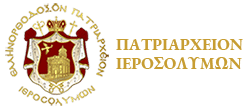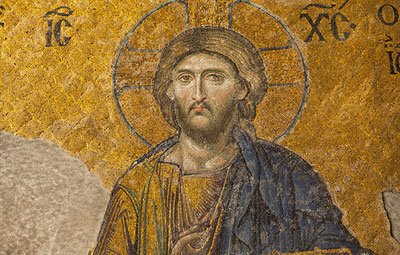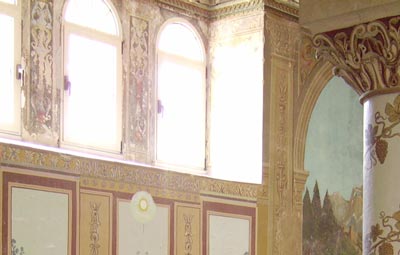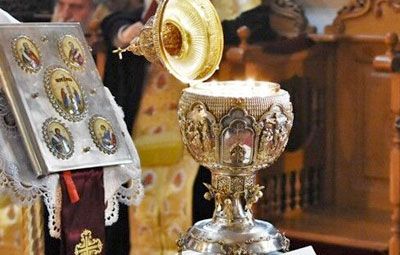St Sabbas
Saint Savvas’ childhood and the renouncing of the world (439-456)
Saint Savvas the Sanctified was born of pious and wealthy parents in the town Moutalaski of Cappadocia in 439 A.D. His father, who worked for the armed forces, was bound to move to Alexandria with his wife for military purposes so the bringing up of five-year old Savvas was assigned to his relative Ermia. After a few years, the ongoing dispute between Savvas’ two uncles about the management of his parents’ property in combination with his aunt’s inept behaviour towards him, made the young boy renounce the world and join a monastery with the name Flavianes. There, he cherished learning the Psalter and the monastic duties, as well as the exercise of the godlike virtues, becoming preeminent in sobriety, corporal affliction, humility and obedience. He was unrivalled among 65 monks who lived with him. God wanted to foretell the measurement of his holiness and gave him the grace of steadfast and miraculous faith. Once, armouring himself with the sign of the cross, Savvas entered a burning hot oven and totally unharmed, brought out the baker’s clothes that the latter had forgotten there.
Palestine. Monastic training at Saint Theoctistos’ monastery near Euthymios the Great.
Having fulfilled ten years of monastic striving at the monastery of Flavianes, Savvas asked the Hegoumen’s blessing for his permanent transition to the Holy City Jerusalem; his desire was the constant rising from glory to glory through hesychasm in the desert. The Hegoumen gave his blessing and so the eighteen-year old Savvas arrived in Jerusalem and was hosted at the Monastery of Saint Passarion for the winter of the years 456-457 A.D. Despite Archimandrite Elpidios and the other monks’ exhortation to stay with them, Savvas’ mind was filled with the desire to join the anchorites under the guidance of Euthymios the Great, that’s why he received the blessing from Elpidios and went to meet Great Euthymios.
Euthymios refused to keep Savvas in his Lavra and sent him back to the monastery of Father Theoctistos asking him to take care of Savvas. Euthymios the Great acted in this manner, to give an example to Savvas so as not to accept teenagers once he would have founded his own Lavra and would have become legislator and guide for all anchorites in Palestine. Young Savvas accepted Euthymios’ conduct as if it were God’s Will, and obeying Father Theoctistos, he reinforced his former striving with fasting, vigil, humility and obedience, adding love and skilfulness in the church services, efficient ministry and service of the other monks.
Savvas remained in this marvellous manner of life for ten years, until Saint Theoctistos’ death and two further years, until the death of Theoctistos’ successor Maridos. Saint Savvas asked the blessing from the new Hegoumen Logginos to lead the hesychast life, and the Hegoumen gave his blessing taking into consideration the great virtue of the Saint and the council of Euthymios the Great. Since then, Saint Savvas lived in a cave south of the monastery for five years, during which he was constantly praying and abstained from food five days a week, while only at the weekends he would return to the monastery to bring his handicrafts and participate in the common prayers. During Great Lent, Saint Savvas stayed with Euthymios the Great and his student blessed Dometianos in the Rouva desert, between Brook Kidron and the Dead Sea, fasting, scarcely drinking water, keeping prayers and vigils. On 20th January 473 our Father in God Euthymios the Great slept in peace.
Foundation of the Holy Lavra and the Saint’s assignment as leader of the anchorites (473-493)
After the Saint’s death, Saint Savvas did not wish to return to the monastery but headed towards the east deserts of Rouva and Koutyla; it was at the same time when Saint Gerasimos of Jordan was distinguished in the desert of the river Jordan. In these deserts, Saint Savvas established a spiritual bond with Saint Theodosius the Cenobiarch through monk Anthos, with whom Saint Savvas lived for four years. At that time he achieved total fearlessness towards the demons and the wild beasts, together with the barbarians’ respect due to his virtues and faith in God. After these he was ordered by an Angel on the mountain of Eudokia, and he moved to a cave, which is called Saint Savvas’ cave to this day, on the east side of Brook Kidron opposite the Lavra. Five years later, hermits and anchorites, who became his first entourage in Lavra, began joining him in the surrounding area reaching the number of 70 in the year 483. After the initial organization of the Lavra and the miraculous gushing of blessed water with the Saint’s prayer, Saint Savvas saw a pillar of fire rising up in the sky on the west side opposite his cave. Having researched the place of the miracle, the next day he found the God-built cave which had a suitable shape for a church. This became the central place in the Lavra around which he organized the other activities. His entourage was of one hundred and fifty monks then.
However, it would have been impossible for the devil not to increase the temptations against such a divine plan. Saint Savvas was despised and slandered by his own monks, who asked Patriarch Salloustios for the Saints’ replacement in the position of the Hegoumen. Instead of granting their wish, Patriarch Salloustios ordained him Priest – knowing his holiness – and refurbished the God-built church on 12th December 491.
The attendance of new monks, especially Armenians, was continuously increasing, as well as the miracles and the ascetic striving of the Saint, who exercised a supernatural manner of life during Great Lent in the desert. Saint Ioannis, Bishop of Cologne, joined the monks of the Lavra, and became exalted for his virtue. In 492, Saint Savvas built a Coenobitic monastery at the fortress of Kastellion, in the desert, north-east of the Lavra. After a short while, Patriarch Salloustios proclaimed Savvas leader and legislator of all anchorites and cellulites, who would be eligible to the Holy City, while Theodosius the Cenobiarch would be leader and archimandrite for all Coenobitic Monasteries. For this, Saint Savvas would say jokingly to Saint Theodosius that he was “Hegoumen of the Hegoumens”, while Theodosius was “Hegoumen of children”, meaning novices.
The building of the Church of the Annunciation. Saint’s departure from the Lavra (494-508)
The reconstruction work of the Great Church of Theotokos began in 494 and was completed in July 501 because the God-built church and the small chapel did not suffice for the liturgical demands of the Lavra.
However, the monks who had accused the Saint a few years before, rebelled against him again to such an extent that the Saint was forced to leave the Lavra so as not to disturb them further. His absence lasted for five years (503-508), during which he founded two new Coenobitic Monasteries in Gadara and Nikopolis. Finally, his restoration at the position of Hegoumen resulted in the mutineers’ escape from the Great Lavra, and their settlement in a new Lavra; however, the benignant Saint helped them to build and organize their Lavra, assigning blessed Ioannis as their Hegoumen.
The foundation of new Monasteries and his fight against Monophycitism
In the subsequent years the Saint worked for the spiritual growth of his monks. By the time of his death he had founded another two Lavrae, Eptastomou (512) and Jeremiu (531), as well as two more Coenobitic Monasteries, Spileou (509) and Scholariou (512). More wondrous actions brightened the last twenty years of his life, with significant importance in the Church history. Under the allocations of the Monophycist Emperor Anastasios (491-518) and the prime movers of Monophycism “Headless” Seviros, Philoxenos, and Sotirihos, the Orthodox Churches in the East were gradually assigned to Monophycist Bishops. After the encouragement from the Orthodox Patriarch of Jerusalem Elijah (494-516), Saint Savvas went to Constantinople in 512, where with his holiness and fame, managed to convince the Emperor to inhibit Elijah’s exile. When in the following year the Orthodox Patriarch’s deportation by the Emperor was at hand, Saint Savvas gathered all the desert monks in Jerusalem to protect Elijah, and anathematized the Emperor’s heretic delegates. He acted in a similar manner three years later, in 516, with the help of Saint Theodosius the Cenobiarch, in order to establish the new Patriarch of Jerusalem John iii (516-524) in Orthodoxy. This action preserved the Church of Jerusalem in the correct faith at the time when the Churches of Constantinople, Alexandria and Antioch had been assigned to Monophycist Patriarchs. Later on, Orthodoxy was fully restored.
Continuation of Saint Savvas’ blessed life. Meeting with Justinian in Constantinople. The Saint’s death (516-532)
Saint Savvas’ second journey to Constantinople was in 530, when he was 90 years old. He then succeeded in the exemption of Palestine from the strict measures that Emperor Justinian wanted to impose, as a consequence of the riots due to the uprising of the Samaritans and the Jews (529). The Saint also encouraged the noble King – who had witnessed Savvas’ holiness in a vision – to prosecute the heresies of Arios, Nestor and Origen, and proceed to beneficial works in Palestine through which he would convey the expansion of the Empire in Africa and Italy. Indeed, Saint Savvas’ prophesy and blessing was fulfilled. The victories of Generals Velissarios and Narses brought back to the Emperor the west parts of the Empire. Such was Saint Savvas’ prophetic grace!
Such was the measure of his grace, that he stopped with his prayer the five-year draught that had been the consequence of God’s wrath for the unjust deportation of Patriarch Elijah in 520. However his return from the reigning city meant the beginning of the end for his earthly life. Saint Savvas found rest from his hard toil on 5th December 532. He had lived in the monastery of Flavianes for 10 years, until his 18th year of age, 17 years in the Coenobitic Monastery of Saint Theoctistos in Palestine, and 59 years in the desert and in the Great Lavra. In the year 547, his sacred relic was found intact in his tomb, it was transferred in Constantinople many years later and the Crusaders took it to Venice in 1204. In 1965 it was permanently returned in the Great Lavra. The unprecedented impact of his life to the faithful Christians resulted in the writing of this life by Cyril of Skythopolis in 557, since according to the words of our Lord Jesus Christ, the making of men is made known by the fruit of their labour. The subsequent course of Saint Savvas’ Great Lavra constitutes the fruit of the Saint’s virtues and proof of his glory and parresia (frankness) he found by God, gifts of grace through which he preserves to this day the most significant monastic habitation of Judea. Frankly, the Saint’s uncountable miracles make us marvel, together with the resonance of the monastic life of his Lavra, which became a prototype with a significant role in the shaping of monastic life and the liturgical order of the Church worldwide; it has also offered a multitude of holy men, among whom is Saint John of Damascus, a prominent theologian of the 8th century. Saint Savvas’ honour was rapidly spread from Rome to Georgia of Caucasus. His successors in Hegoumenia established the Lavra as a bastion of Orthodoxy in Palestine against Origenism, Monothelitism, Iconoclast and Papacy with a worldwide range resonance of the Orthodox faith. The Lavra was highlighted as the training centre of the Hagiotaphite Brotherhood, giving its members the primary education of monasticism and experience of the Church order. All these are owed to the prayers and example of Saint Savvas: “Bright are the divine gifts of our enlightened Father in God Savvas, his works glorious, his life chaste and his faith Orthodox. And this, only in part has been proven with what has been written here”.









